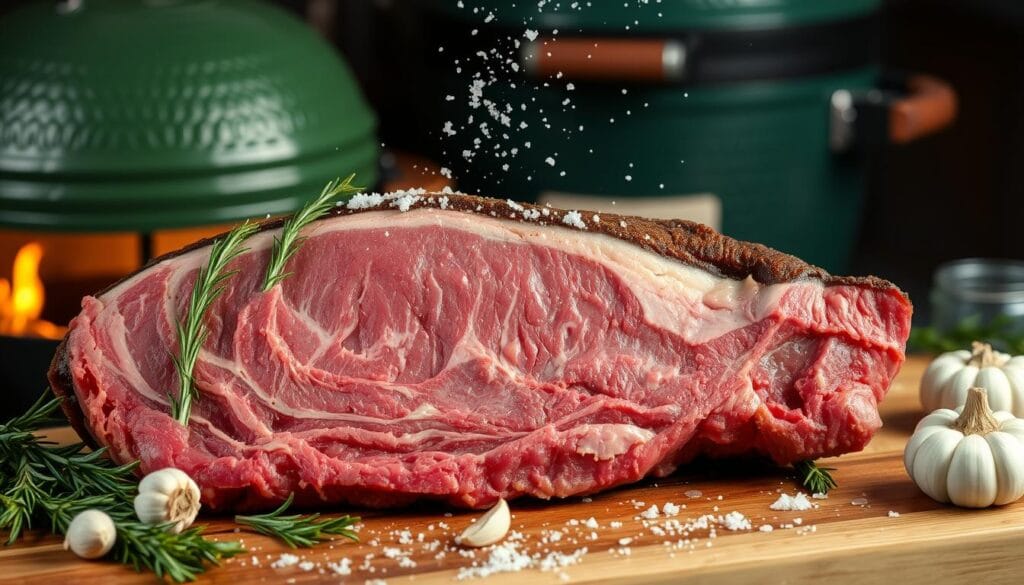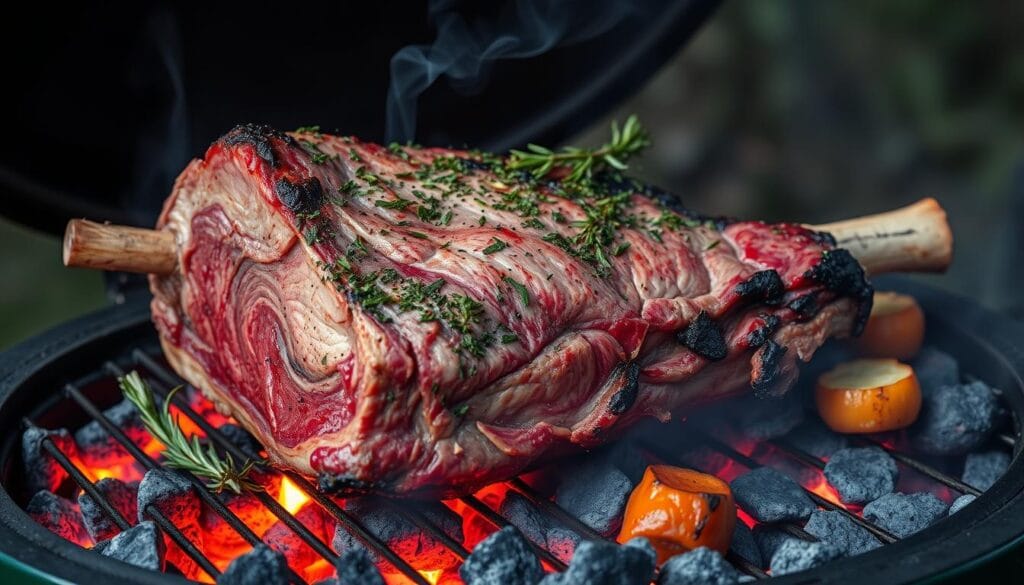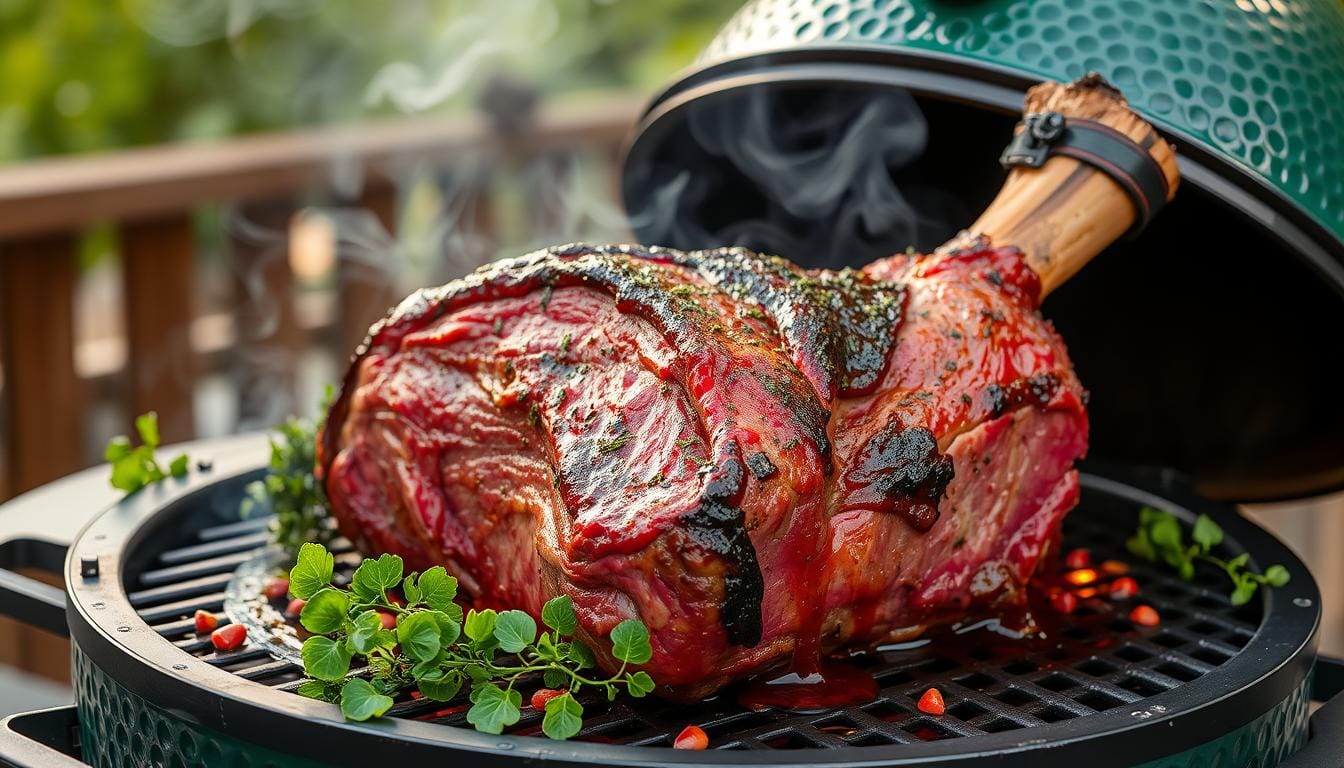Cooking a prime standing rib roast on a Big Green Egg is an art. It needs knowledge and practice. A prime standing rib roast green egg is great for special occasions. With the right techniques, you can make a delicious prime rib.
Cooking a prime standing rib roast on a Green Egg is fun and rewarding. It’s great whether you’re experienced or new. This article will give you the knowledge to impress your friends and family with a tasty prime standing rib roast green egg.
Key Takeaways
- Cooking a prime standing rib roast on a Big Green Egg requires some knowledge and practice
- A prime standing rib roast green egg is a perfect dish for special occasions
- Using the right techniques can help you achieve a deliciously cooked prime rib
- Cooking on a Green Egg can be a fun and rewarding experience
- Having the right tools and ingredients is essential for cooking a big green egg standing prime rib roast
- This article will provide you with a step-by-step guide to cooking a prime standing rib roast on a Green Egg
What is a Prime Standing Rib Roast?
A prime standing rib roast is a cut of beef from the rib section. It’s known for its rich flavor and tender texture. This cut usually has 6-8 ribs and comes from the 6th to the 12th rib.
When searching for a prime rib roast, quality is key. You want it to be juicy and flavorful. A good balance of marbling and fat is essential for this.
Understanding the Cut
Knowing the cut of a prime standing rib roast is important. It affects the meat’s tenderness, flavor, and quality. A high-quality roast has the right amount of marbling and fat, making it great for slow cooking.
The Best Quality Choices
To choose the best prime standing rib roast, consider these factors:
- Look for a roast with a good balance of marbling and a thick, even layer of fat
- Choose a roast that is cut from the 6th to the 12th rib for optimal tenderness and flavor
- Consider the size of the roast, as a larger roast will be more impressive but may be more challenging to cook evenly
A prime standing rib roast is a dish that will wow your guests. By understanding the cut and choosing the best quality, you’ll create a memorable meal.
Benefits of Grilling on a Big Green Egg
Grilling on a big green egg gives you a special cooking experience. It can make your prime rib even better. The egg’s ceramic design spreads heat evenly, so your prime rib cooks well all over.
This is great for big pieces of meat. It stops hot spots and undercooked parts.
Grilling on a big green egg lets you cook at high temperatures. This makes the outside of your prime rib crispy and the inside juicy. Plus, it adds a smoky taste that’s hard to get with other methods.
Unique Cooking Features
The big green egg has special features for grilling prime rib. Some key ones are:
- Even heat distribution
- High temperature cooking
- Smoky flavor infusion
Flavor Enhancement
Grilling on a big green egg also boosts your prime rib’s flavor. The egg’s ceramic keeps the meat’s natural taste. The smoky flavor adds a rich, savory taste.
To enhance your big green egg experience, try different wood chips or chunks. They can give your prime rib unique flavors.
Preparing Your Prime Standing Rib Roast
Choosing the right size of prime rib roast is the first step. It affects cooking time and meat tenderness. A good rule is to pick a roast of at least 1 pound per person. This ensures everyone gets a good serving and the meat is perfectly cooked.
Choosing the Right Size
The size of the prime rib roast is key for cooking time and tenderness. Think about how many guests you’ll have and the serving size you want. Here are some guidelines:
- Small: 2-3 pounds, serves 2-3 people
- Medium: 4-6 pounds, serves 4-6 people
- Large: 7-10 pounds, serves 7-10 people
Necessary Tools and Ingredients
You’ll also need some tools and ingredients for your prime standing rib roast. You’ll need a meat thermometer, a roasting pan, and seasonings. Herbs and spices like garlic, rosemary, and thyme can add flavor.

By following these tips, your prime standing rib roast will be perfect. Your guests will enjoy a delicious and memorable meal. Whether it’s for a special occasion or a weekend dinner, the right size and tools are key to the meat’s flavor and tenderness.
Seasoning Your Roast for Maximum Flavor
Seasoning is key to bringing out the best in your prime standing rib roast. The right mix can make the meat’s natural flavors pop. Try a prime rib rub with garlic, thyme, and rosemary for a savory taste.
Timing is everything when seasoning. Season your prime rib at least 24 hours before cooking. This lets the flavors soak into the meat without being too strong. Popular rubs include herbs and spices that match the meat’s natural taste.
Popular Seasoning Options
- Garlic and herb prime rib rubs
- Lemon pepper seasoning for a bright, citrusy flavor
- Classic seasoning blends featuring thyme, rosemary, and black pepper
Choosing the right seasoning and timing can make your roast stand out. Whether you buy a rub or make your own, aim for a flavor balance that enhances your roast.
Setting Up Your Big Green Egg
To get the perfect prime standing rib roast, setting up your Big Green Egg is key. You need to pick the right charcoal and prepare it as the maker says. The charcoal you choose greatly impacts the taste and heat of your roast.
A good big green egg setup means your roast will cook evenly and at the right heat. Here are some important things to think about for setting up your Big Green Egg:
- Choose the right type of charcoal for your big green egg setup, considering factors such as burn time and flavor profile.
- Prepare the charcoal according to the manufacturer’s instructions to ensure a consistent burn.
- Learn how to control the temperature of your Big Green Egg using the vents and a temperature gauge.
By following these steps and picking the right charcoal, you’ll get a perfect big green egg setup for your prime standing rib roast. Always follow the maker’s instructions for your Big Green Egg model.
With the right big green egg setup and charcoal, you’ll cook a tasty prime standing rib roast. It will impress your friends and family.
| Charcoal Type | Burn Time | Flavor Profile |
|---|---|---|
| Lump Charcoal | 4-6 hours | Smoky, rich flavor |
| Briquettes | 6-8 hours | Mild, consistent flavor |
Cooking Techniques for Prime Rib
There are several ways to cook prime rib. You can choose between direct or indirect heat. Direct heat means placing the prime rib over the coals. Indirect heat means placing it to the side. Your choice will affect the taste and texture of your prime rib.
Direct heat can give a nice crust on the outside. Indirect heat helps cook the prime rib evenly. To get the best prime rib, you need to know how to use both direct and indirect heat.
Understanding Heat Distribution
Even heat is key when cooking prime rib. To cook it evenly, you should rotate the prime rib often. This prevents some parts from getting too hot. Also, using a meat thermometer is important to check the internal temperature.
Some important things to remember when cooking prime rib include:
- Using a meat thermometer to ensure the perfect internal temperature
- Rotating the prime rib regularly to prevent overcooking
- Mastering prime rib cooking techniques, such as direct and indirect heat
By following these tips, you can make a delicious prime rib. It’s perfect for any special occasion or a simple dinner. 
Resting and Carving the Roast
After cooking your prime standing rib roast, it’s key to let it rest before carving. This step helps the juices spread out and the meat relax. It makes carving easier and improves the taste and tenderness of the meat.
To carve the prime rib perfectly, you’ll need a sharp knife and a carving board. Start by slicing the prime rib against the grain, using a gentle sawing motion. Here are some steps to follow:
- Place the prime rib on a carving board, allowing it to rest for at least 15-20 minutes.
- Use a sharp knife to slice the prime rib against the grain, applying gentle pressure.
- Use a carving fork to hold the prime rib in place while slicing.
By following these steps, you can ensure a perfectly resting prime rib and a beautifully carving prime rib that will impress your guests. Always use a sharp knife and slice against the grain for the most tender results.
With these tips, you’ll be well on your way to becoming a master carving prime rib chef. Happy cooking!
| Step | Description |
|---|---|
| 1 | Let the prime rib rest for 15-20 minutes. |
| 2 | Use a sharp knife to slice against the grain. |
| 3 | Use a carving fork to hold the prime rib in place. |
Pairing Sides and Sauces
Choosing the right sides for prime rib can really enhance the meal. Options like roasted vegetables, mashed potatoes, or a fresh salad are great. They add a nice contrast to the tender prime rib.
Adding the right sauces can also boost the flavor. Horseradish sauce or demiglace are popular choices. But you can also try au jus or tangy BBQ sauce. Other great options include:
- Beef gravy
- Béarnaise sauce
- Chimichurri
These sauces and condiments add more flavor to your meal. They pair well with your prime rib sides. By picking the right sides and sauces, you’ll create a delicious meal that impresses everyone.
Finding the right balance of flavors and textures is key. By considering these options, you’ll make a memorable meal for your guests.
| Prime Rib Sides | Prime Rib Sauces |
|---|---|
| Roasted vegetables | Horseradish sauce |
| Mashed potatoes | Demiglace |
| Fresh salad | Au jus |
Tips for Success on Your Next Cook
When you start cooking a prime standing rib roast on the Big Green Egg, remember these tips. First, don’t overcook the meat or forget to season it. Use a meat thermometer to check the internal temperature. Also, try different rubs and marinades to find your favorite flavor.
Avoiding Common Mistakes
One big challenge is keeping the meat at the right doneness. Don’t open the lid too often, as it can mess with the temperature. Also, let the meat rest for 15-20 minutes before slicing. This helps keep the juices inside.
Expert Recommendations and Tricks
To add moisture and flavor, put a pan of water on the lower rack. This creates steam, making the roast tender and juicy. Also, try different wood chips or chunks for unique smoky flavors. With practice and these tips, you’ll get better at prime rib cooking on the Big Green Egg.

